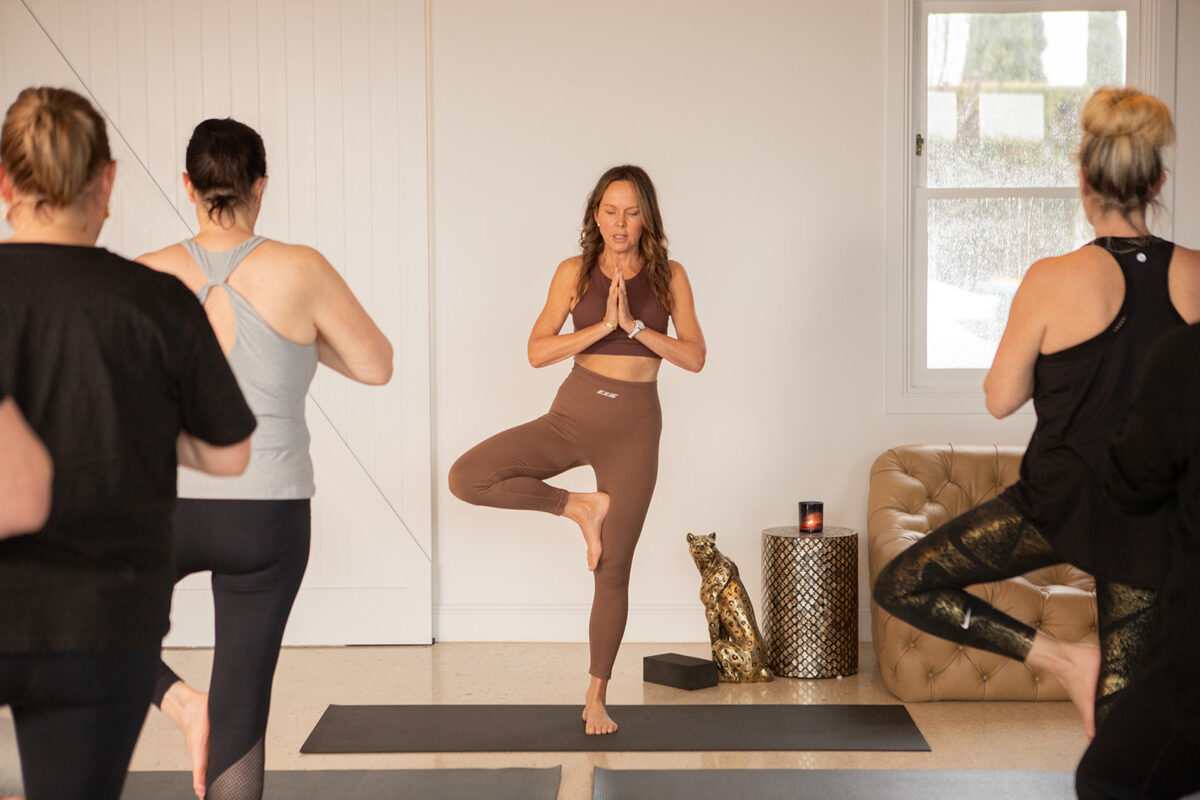Turning 50 is a huge, exciting milestone for many people. As a 57-year-old I am well aware of the effect the decades have had on my mind and body… some positively, some confronting…From age 50 and onwards is a time when our bodies begin to change — and so do our physical and emotional needs. As such, we all know that a balanced diet, regular exercise to maintain strength, balance and mobility, and managing stress are paramount as we age. Often, that’s easier said than done. Do you agree?
Indeed, we all want to improve our odds of healthy aging and continue living a dynamic, active lifestyle. Sometimes though, we’re not sure where to start and how to maintain the momentum.Trying to get back in shape is frustrating at any age; but it can be even more discouraging when you’re older and wondering whether it’s even possible. Rest assured, getting fit after 50 is absolutely possible.
“Longevity shouldn’t just mean living longer……It should mean living better as you age — with an overwhelming sense of vitality, purpose, and joy.” And the key to thriving as the years go on is safeguarding your physical and mental health. How so? Ageing refers to the physiological changes we experience during our lifespan. It’s also an inevitable part of life. Our cells aren’t created to last forever. So, structures and functions in our cells decline over time. That’s the physiological part…But why exactly makes this aging process happen? For many years researchers have been studying that question! There are currently more than 300 theories on why we age, and we are learning more every day. There is Intrinsic aging, a genetically predetermined process that occurs naturally. Then there’s also Extrinsic aging, which is a result of the lifestyle factors and choices we make such as where you live, your stress levels, and your lifestyle habits (like diet, exercise alcohol and smoking).
What bodily changes happen in your 50s and 60s?
Since the day we are born, our bodies have continued to change and evolve based on your age, environment, and lifestyle. As we reach our 50s and 60s, we must give attention to several important changes.
Muscle loss
Age-related muscle loss, also known as sarcopenia, involves the gradual decline in muscle mass as we age. From the age of 40, we lose an average of 8% of your muscle mass every 10 years. By age 70, this rate increases up to 15% per decade so that could be 40% muscle loss from 40-70 years!!! However, it is possible to slow this muscle loss process through healthy lifestyle practices, such as following a protein-rich diet and engaging in regular strength training such as resistance training, weight training and body weight training. The strength training exercises in yogalates that use body weight include lunges, squats, burpees, warrior poses, planks, side planks, birddog and more.
Bone loss
As we age, our risk of osteopenia — or age-related bone loss — increases. To maintain bone strength, our bones undergo a natural cycle called osteogenesis. During this bone regeneration process, bones are broken down by special cells called osteoclasts and then rebuilt more strongly by cells called osteoblasts. Over time, as we age, osteogenesis becomes less effective, meaning that our bones cannot rebuild as effectively or rapidly. This may lead to our bones weakening over time, which may result in decreased mobility , loss of balance and higher risk of falls and bone fractures. A diet with adequate calcium is paramount. Specific strength training exercises allow muscle to pull on the bone and help with regeneration. Specific balance and mobility exercises also help with balance, agility and falls prevention. (refer to my balance exercise blog) These include sit to stand, single stance, heel toe walking, clock taps, step ups, getting on and off floor
Slowed metabolism
A landmark study found that your metabolic rate stays relatively stable from 20–60 years of age but slowly begins to decline after 60 as a result of a decrease in muscle mass and other age-related factors such as diet and physical activity. As you reach your 50s and 60s, focus on preserving your muscle mass through physical activity and good nutrition. These practices may also prevent stiffness, inflammation and pain, much of which is tied to an increased risk of chronic health issues and accelerated aging.
Inflamm-aging
While we can’t stop the process of aging, we can take action to ensure that we are ageing as well as possible. One way is to manage inflamm-aging, an age-related inflammatory process that increases the chance of chronic conditions. Acute inflammation is vital for the body’s healing process, it is necessary for growth and repair of body tissues and organs and is short term. Although, chronic inflammation (which often goes unnoticed) can trigger a variety of common diseases that become apparent as we get older, including Alzheimer’s disease, heart disease, gut issues, arthritis, cancer, and diabetes. By managing chronic inflammation with healthy lifestyle habits, can assist to avoid or slow the progression of inflammation-related chronic illnesses. Some of the tips I give my physiotherapy clients include:
-
Eat an anti-inflammatory diet
Modifying your diet to include foods packed with antioxidants and polyphenols can play a positive role in managing inflamm-aging. I recommend eating a Mediterranean diet, which includes the following anti-inflammatory foods:
- fruits, such as blueberries, cherries, oranges, and strawberries
- fatty fish, such as salmon and sardines
- leafy greens, such as kale and spinach
- nuts, such as almonds and walnuts
- olive oil
- tomatoes
- whole grains
-
Move your body
There is plenty of research which has studied the correlation between physical activity and inflammation. A recent study suggested that regular exercise is a natural anti-inflammatory agent that can prevent or delay chronic inflammation as you age. Find an exercise that you enjoy and make a regular part of you week;
- Walking in nature
- Group classes
- Balance and mobility training
- Yoga and Pilates
- Swimming
- Bike riding
- Dancing
What does healthy ageing look like?
The main goal of this effort is to extend the number of healthy, active years you have. In many cases, you can live a very active lifestyle well into your late adulthood. As discussed, numerous factors affect healthy aging, such as:
- diet
- physical activity
- health conditions and medical history (including heart disease, type 2 diabetes, cancer, and mental decline)
- genetics
- social support and a sense of connection
- smoking and substance use
- access to quality medical care
- mindset
- having a purpose
Strength training.
Do strength training for all major muscle groups at least twice a week. Consider free weights, weight machines or activities that use your own body weight — yoga, Pilates yogalates or hobbies such as rock climbing or heavy gardening. You can do an exercise circuit at home with squats, step ups, sit to stand, roll ups, birdies, planks or lunges. Aim to do a single set of each exercise, using a weight or resistance level heavy enough to tire your muscles after about 12 to 15 repetitions.
Balance and mobility training
Finding balance in all areas of your life is the way forward. This includes developing balance in your body. Improving balance increases coordination and strength, allowing you to move freely and steadily. Enhancing stability, mobility, and flexibility makes it easier to perform your daily tasks, prevent falls and also improves your athletic performance at any age. Focusing on your balance may also help you to focus and clear your mind. Yoga, Pilates and specific balance exercises as mentioned above are worthwhile. Or join a balance and mobility class.
Get the Right Mindset
No matter whether you’ve been sedentary for two or 20 years, you’re never too old to get back in shape. If you have extra weight to lose and you’ve lost muscle tone, regular exercise can help you reach your fitness goals. The key is to make a plan and stick to it.
Exercise your brain
Any activity that involves thinking and learning can improve your brain health and help protect against dementia. Evidence suggests that greater benefit comes from more complex and challenging mental activities. The more brain activities you do, the more frequently you do them and the more complex the activity, the lower your risk of dementia is likely to be. The best activities are those that you enjoy – boredom and frustration are not good for your brain. The types of activities include:
- enjoying hobbies like painting, woodwork, sewing or writing
- Try yogalates that requires remembering sequences and technique as well as responding to verbal and visual cues
- doing a short course
- doing a jigsaw, crossword, number or word puzzle
- learning to dance, play an instrument or speak a new language
- going to the theatre, movies, museum, gallery or a concert.
Find a purpose
Living a life of intention or having a purpose in life, especially as you age, is integral to healthy living and longevity. Many studies have shown that aging with purpose can provide protection against Alzheimer’s disease, disabilities, cardiovascular problems, and impairment, and lead to longer, happier lives.
- Nurture friendships
- Stay strong and healthy ok
- Create projects
- Play games or sport
- Join a social or hobby group
- Volunteer or join community projects
- Study something new
Embrace aging
So, as we age, we have a choice: we can either cling to the world as we shaped it and refuse to engage in self-care, self-awareness, learning and growth, the new world our kids’ and grandkids’ generations are creating, or we can remain curious, active participants in it. This to me is at the heart of aging happily, dynamically and to aging well. Our goal shouldn’t be to cling to youth as we get older, but to keep our body and mind alive by tending to ourselves throughout our days while also nurturing our connection to the changing world. In doing so, we find, balance, curiosity, wisdom, strength, confidence and joy!
I am looking forward to the next few decades…
How about you?
Lisa Wilson
Physiotherapist/ Pilates- yoga consultant/ Director
M: 0417553184

